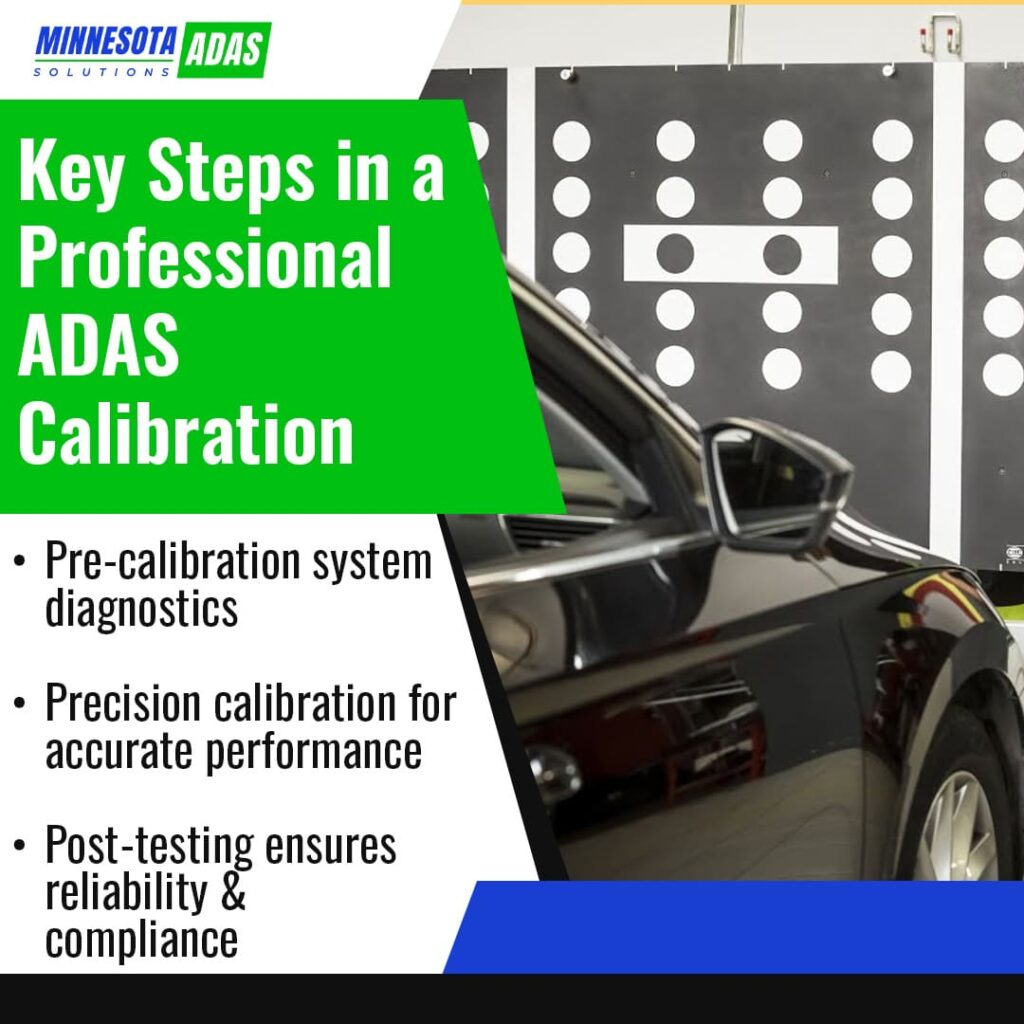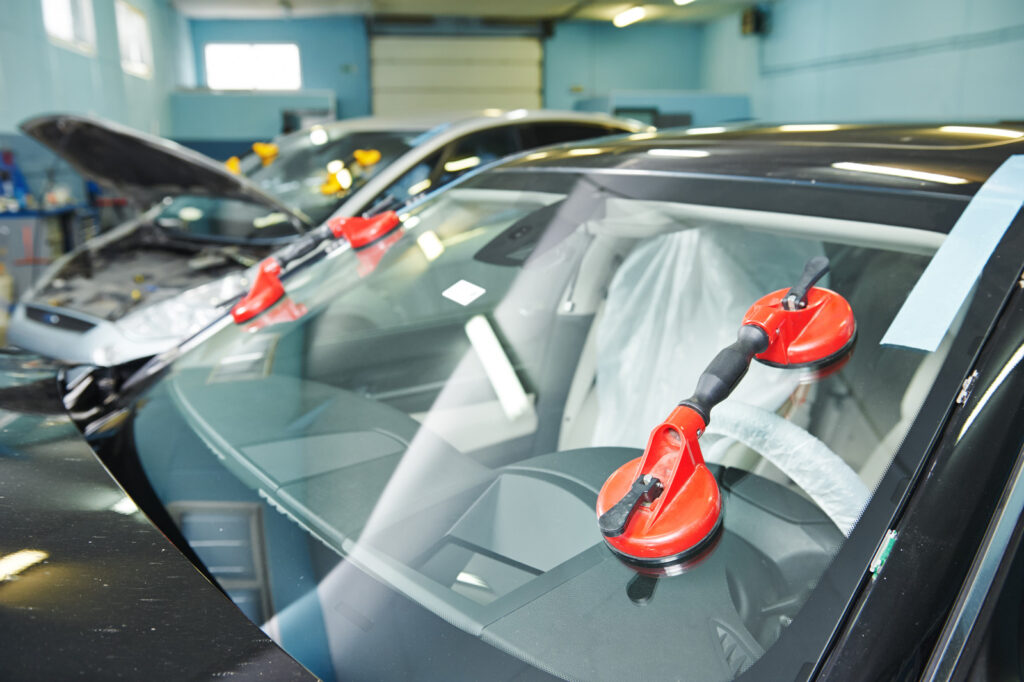A windshield replacement is more than just swapping out the glass. If your vehicle is equipped with advanced driver assistance systems (ADAS), the cameras and sensors mounted on the windshield must be precisely realigned. Without ADAS camera calibration, features like adaptive cruise control, lane departure calibration, and emergency braking may not function correctly. Even a slight misalignment can affect the lane departure system, leading to delayed or incorrect warnings.
At Minnesota ADAS Solutions, we specialize in ADAS sensor calibration and ADAS windshield calibration to restore your vehicle’s safety features to manufacturer standards. Your vehicle relies on accurate data from these systems to detect lanes, traffic, and obstacles. If calibration is skipped, your safety is at risk. Whether you’ve had your windshield replaced or suspect an issue with your ADAS, professional calibration guarantees that your systems work as expected.

The Role of ADAS in Modern Vehicles
Advanced Driver Assistance Systems (ADAS) are built to improve driving safety by reducing human error. Features like adaptive cruise control and lane departure systems depend on precise data from sensors, cameras, and radars. Many of these components are mounted on the windshield, giving them a direct view of the road. If anything affects their positioning even slightly, their accuracy can be compromised.
A vehicle’s ADAS camera calibration is programmed to recognize lane markings, detect nearby vehicles, and respond to changing road conditions. Adaptive cruise control adjusts speed based on surrounding traffic, while lane departure calibration helps prevent unintentional drifting. These features work together to assist drivers, but they can only do so if their data is reliable.
Replacing a windshield disrupts the alignment of these cameras and sensors. The new glass may have a different thickness, curvature, or mounting angle, which can throw off the system’s calibration. This is why ADAS camera calibration and ADAS sensor calibration are necessary after any windshield replacement.
Without proper recalibration, the lane departure system may not detect lane markings accurately. Adaptive cruise control might misjudge distances, leading to delayed or incorrect speed adjustments. Even emergency braking could be affected, increasing the risk of accidents.
At Minnesota ADAS Solutions, we specialize in ADAS windshield calibration to restore your vehicle’s safety features to their original settings. With expert calibration, your ADAS system will function smoothly, giving you confidence on the road.
How Glass Replacement Affects ADAS Camera Alignment
Replacing a windshield does more than just swap out a piece of glass. It directly impacts the alignment of ADAS cameras, which are responsible for key safety functions. These cameras rely on precise positioning to interpret road markings, detect obstacles, and regulate vehicle behavior. Any disruption to their alignment can lead to inaccurate readings, making the vehicle’s safety systems unreliable.
The Impact of Glass Replacement
Even a minor shift in the mounting position of an ADAS camera can affect its calibration. A difference in glass thickness, mounting angle, or installation position can cause the camera to misinterpret its surroundings. This can lead to incorrect calculations for ADAS sensor calibration, affecting systems that control speed, steering, and braking.
When the calibration is off, the lane departure calibration may fail to detect when the vehicle drifts out of its lane. Adaptive cruise control may struggle to maintain a safe distance from other vehicles, potentially causing unexpected speed changes. The effect may not be immediately noticeable, but over time, small errors in calibration can lead to dangerous driving conditions.
Examples of Issues Caused by Misalignment
Lane Departure Calibration: If the camera’s angle is even slightly off, the system may not recognize lane markings correctly. This can prevent the lane departure system from alerting the driver when the vehicle begins to drift.
Adaptive Cruise Control: A misaligned camera can misjudge the distance to other vehicles, leading to improper speed adjustments. The system might brake too late or fail to slow down when approaching traffic, increasing the risk of collisions.
Emergency Braking Assistance: Some vehicles use windshield-mounted ADAS cameras to detect pedestrians or obstacles. A misalignment could result in the system failing to activate braking at the right moment.
Windshield replacement is more than just a structural repair—it directly affects the vehicle’s safety features. Minnesota ADAS Solutions specializes in ADAS camera calibration, ADAS sensor calibration, and ADAS windshield calibration to restore proper alignment after glass replacement. By recalibrating the system to meet manufacturer specifications, we help maintain the accuracy of lane departure calibration and adaptive cruise control, keeping your vehicle safe on the road.
The Necessity of ADAS Camera Calibration After Glass Replacement
After replacing a windshield, it is important to calibrate the ADAS camera to maintain the vehicle’s safety features. Proper calibration helps systems like lane departure warnings and adaptive cruise control work correctly. Without it, these features may not function as intended, increasing the risk of accidents.
Why Calibration is Vital
ADAS cameras play an important role in a vehicle’s safety system. These cameras depend on accurate alignment to function as intended. After windshield replacement, the camera’s alignment may be affected, causing it to work improperly. Calibration adjusts the camera’s position to match the specifications set by the Original Equipment Manufacturer (OEM). This process helps the systems that rely on the camera to function correctly.
Without proper calibration, ADAS features may not detect lane markings, road obstacles, or traffic signs. This can result in situations where the vehicle drifts out of its lane without warning or fails to brake when needed—both of which increase the risk of accidents and put passengers and other road users in danger.
How Calibration Improves Safety
After completing the calibration, the ADAS camera will be positioned precisely as required by the manufacturer’s guidelines. This makes sure that your vehicle’s safety features operate with the utmost accuracy. As a result, the system will effectively detect lane markings and other vehicles around you.
This accurate calibration makes a significant difference. For instance, in an emergency situation, adaptive cruise control can adjust your speed to maintain a safe distance from other vehicles. Lane departure systems can issue timely warnings to prevent you from unintentionally veering off course. Ultimately, these calibrated systems help you maintain a safer driving experience by actively responding to changing road conditions, road hazards, and potential collisions.
What Happens If Calibration is Overlooked?
Skipping the calibration process after windshield replacement is risky. If the ADAS camera calibration isn’t done, your vehicle’s safety features won’t function as designed. This could lead to issues such as undetected lane departures or improper braking, which can put everyone in the vehicle at risk. These safety systems are integral to preventing accidents, and without them working correctly, you might not receive the necessary warnings or responses in time.
It’s clear that calibration isn’t just a technical procedure—it’s an important safety measure that cannot be ignored. By making sure your ADAS camera calibration is done properly, you’re taking a proactive step toward safer driving.
The ADAS Calibration Process: What to Expect
After your windshield is replaced, the ADAS (Advanced Driver Assistance Systems) camera requires calibration to make sure your vehicle’s safety systems are functioning properly. Here’s a detailed look at the steps involved in the ADAS calibration process and what you can expect.
Step 1 – Diagnosis of Camera Misalignment
The first step in the calibration process involves diagnosing whether the ADAS camera or sensors are misaligned after the windshield replacement. A trained technician will assess the camera’s position and evaluate how well it is aligned with the manufacturer’s specifications.
Misalignment can occur during the glass replacement process, which is why this diagnostic step is critical. The technician will check if the camera has been knocked out of place or if its view is obstructed. This examination helps determine if ADAS sensor calibration is necessary to restore the camera to its intended position.
Step 2 – Calibration
If the diagnostic step reveals any misalignment, the technician will proceed with recalibrating the ADAS cameras using specialized equipment. The calibration process involves adjusting the camera’s angle and position to match the OEM (Original Equipment Manufacturer) specifications. These specifications are vital because they make sure that the camera functions in a way that aligns with the safety systems that depend on it.
This step requires precision and expertise, as even a slight misalignment can affect the accuracy of features like lane departure warnings or adaptive cruise control. The calibration process may vary depending on the vehicle’s make and model, but the goal is always the same: to restore the proper alignment so the vehicle’s safety systems perform optimally.
Step 3 – Verification and Testing
Once the calibration is complete, the technician will test all the relevant ADAS systems to confirm that they’re working as they should. The technician will verify that the camera and sensors are responding correctly to road conditions and obstacles, ensuring that your vehicle can actively monitor and adjust its behavior when necessary. The testing phase is very important because it allows the technician to confirm that all adjustments were successful and that the vehicle’s safety features are functioning at full capacity.
After the calibration and verification process, your vehicle’s ADAS systems will be ready to provide accurate, real-time responses on the road, notably improving your driving experience and safety.

Choosing the Right Service for ADAS Calibration After Glass Replacement
After a windshield replacement, it’s vital to make sure that your vehicle’s ADAS (Advanced Driver Assistance Systems) are recalibrated to their proper settings. Professional ADAS calibration services are necessary for restoring the accuracy and functionality of safety features like adaptive cruise control and lane departure systems. Here’s why selecting the right service is so important.
Why Professional ADAS Calibration Matters
Certified ADAS calibration services help maintain the proper function of your vehicle’s safety features. These systems use cameras and sensors to monitor road conditions and respond to potential hazards. If a camera becomes misaligned during a windshield replacement, the system may not detect lane markings, other vehicles, or obstacles accurately. This misalignment can cause errors in lane departure warnings or braking responses, putting drivers and passengers at risk.
Certified technicians have the training and equipment needed to work with the specific systems in your vehicle. Using the proper tools, they restore settings to OEM (Original Equipment Manufacturer) specifications, helping to maintain the accuracy and reliability of the ADAS.
How Minnesota ADAS Solutions Provides Accurate Calibration
At Minnesota ADAS Solutions, based in Bloomington, MN, we specialize in ADAS camera calibration, ADAS windshield calibration, and ADAS sensor calibration. Our team of certified technicians is highly skilled in recalibrating and restoring your vehicle’s safety systems to meet the exact specifications set by the manufacturer.
Using advanced equipment, we make sure that your vehicle’s systems are realigned after any glass replacement. We understand the importance of precision in the calibration process. That’s why we conduct thorough testing to verify that your vehicle’s adaptive systems are functioning properly before returning the car to you.
Our commitment to using advanced technology and following strict calibration protocols means you can trust Minnesota ADAS Solutions to restore your vehicle’s safety features with the accuracy they need to protect you and others on the road.
Prioritize Safety with ADAS Camera Calibration by MN ADAS
Scheduling an ADAS camera calibration right after glass replacement is not just a recommendation but a necessary step to protect everyone in the vehicle. At Minnesota ADAS Solutions, we specialize in ADAS camera calibration, ADAS windshield calibration, ADAS sensor calibration, and lane departure calibration. Our certified professionals use the latest tools and techniques to guarantee your vehicle’s safety systems are recalibrated accurately, ensuring your safety and reliability on the road.
Trust Minnesota ADAS Solutions to keep your vehicle’s safety features functioning as they should. For precision calibration services, contact us today at (612) 425-4230 or email us at info@mnadas.com. Stay safe on the road with the expertise of our trusted team.

